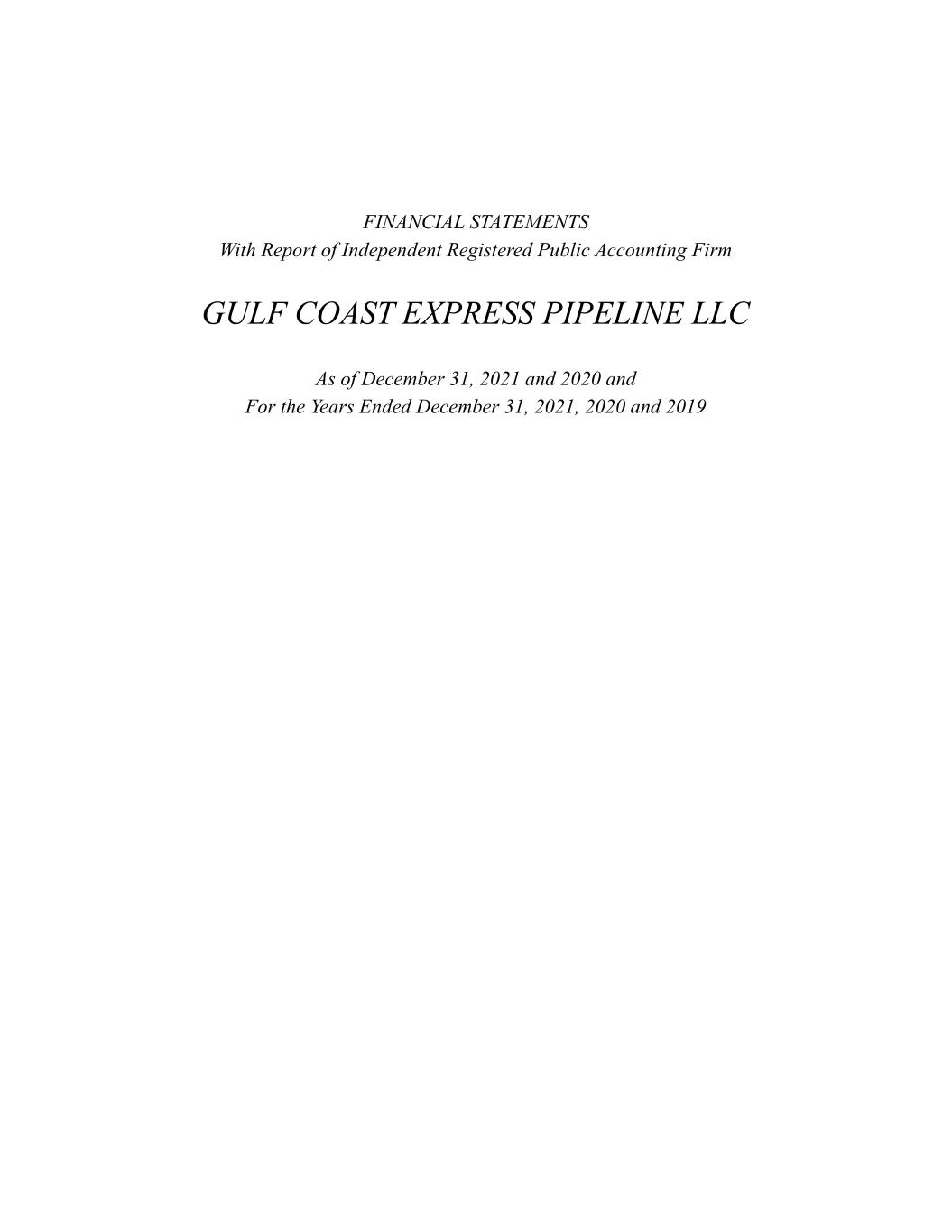
FINANCIAL STATEMENTS With Report of Independent Registered Public Accounting Firm GULF COAST EXPRESS PIPELINE LLC As of December 31, 2021 and 2020 and For the Years Ended December 31, 2021, 2020 and 2019
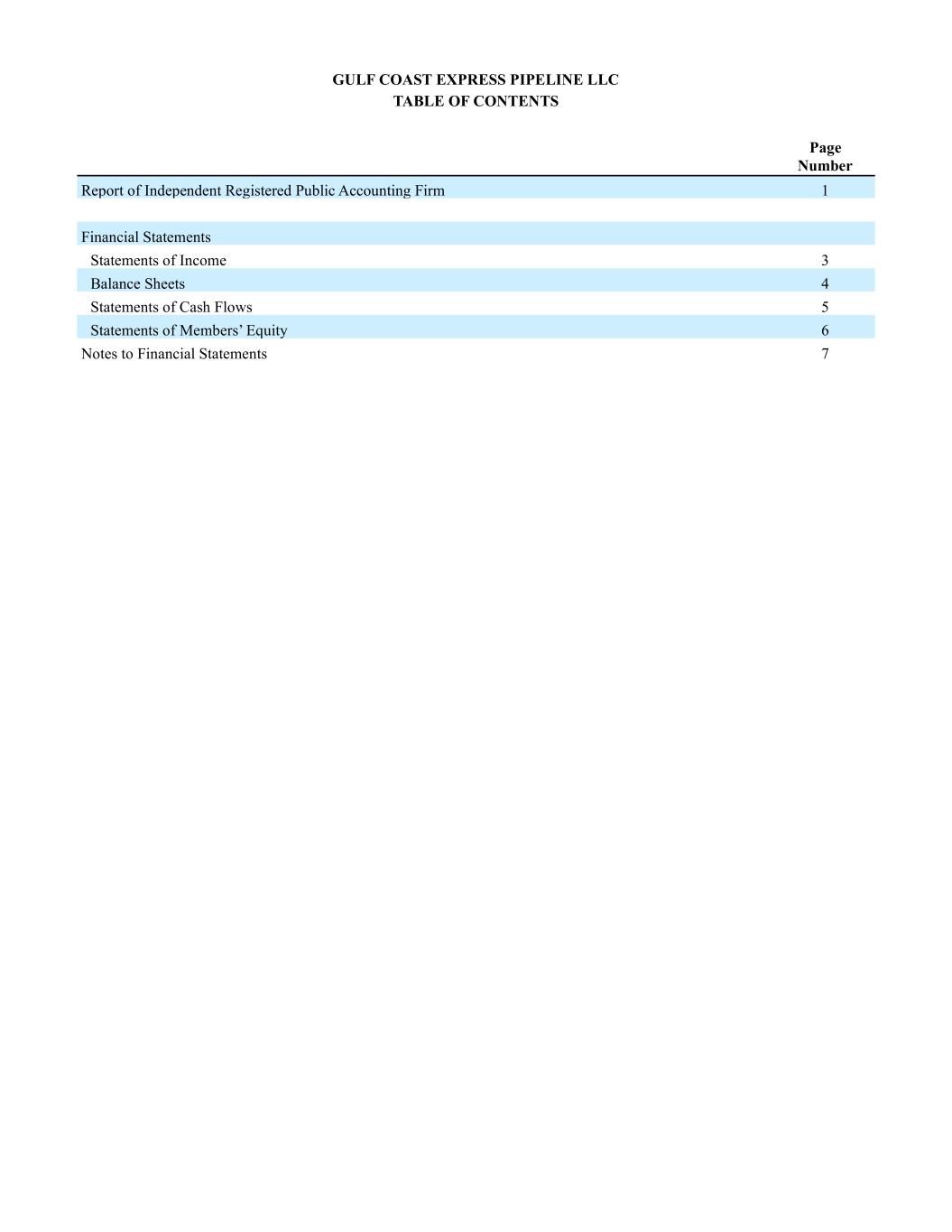
GULF COAST EXPRESS PIPELINE LLC TABLE OF CONTENTS Page Number Report of Independent Registered Public Accounting Firm 1 Financial Statements Statements of Income 3 Balance Sheets 4 Statements of Cash Flows 5 Statements of Members’ Equity 6 Notes to Financial Statements 7

1 Report of Independent Registered Public Accounting Firm Board of Directors and Members Gulf Coast Express Pipeline LLC Houston, Texas Opinion on the Financial Statements We have audited the accompanying balance sheets of Gulf Coast Express Pipeline LLC (the “Company”) as of December 31, 2021 and 2020, the related statements of income, members’ equity and cash flows for each of the three years ended December 31, 2021, and the related notes (collectively referred to as the “financial statements”). In our opinion, the financial statements present fairly, in all material respects, the financial position of the Company at December 31, 2021 and 2020, and the results of its operations and its cash flows for each of the three years ended December 31, 2021, in conformity with accounting principles generally accepted in the United States of America. Basis for Opinion These financial statements are the responsibility of the Company’s management. Our responsibility is to express an opinion on the Company’s financial statements based on our audits. We are a public accounting firm registered with the Public Company Accounting Oversight Board (United States) (“PCAOB”) and are required to be independent with respect to the Company in accordance with the U.S. federal securities laws and the applicable rules and regulations of the Securities and Exchange Commission and the PCAOB. We conducted our audits in accordance with the standards of the PCAOB and in accordance with auditing standards generally accepted in the United States of America. Those standards require that we plan and perform the audit to obtain reasonable assurance about whether the financial statements are free of material misstatement, whether due to error or fraud. The Company is not required to have, nor were we engaged to perform, an audit of its internal control over financial reporting. As part of our audit we are required to obtain an understanding of internal control over financial reporting but not for the purpose of expressing an opinion on the effectiveness of the Company’s internal control over financial reporting. Accordingly, we express no such opinion. Our audits included performing procedures to assess the risks of material misstatement of the financial statements, whether due to error or fraud, and performing procedures that respond to those risks. Such procedures included examining, on a test basis, evidence regarding the amounts and disclosures in the financial statements. Our audits also included evaluating the accounting principles used and significant estimates made by management, as well as evaluating the overall presentation of the financial statements. We believe that our audits provide a reasonable basis for our opinion. Critical Audit Matters Critical audit matters are matters arising from the current period audit of the financial statements that were communicated or required to be communicated to the audit committee and that: (1) relate to accounts or disclosures that are material to the financial statements and (2) involved our especially challenging, subjective, or complex judgments. We determined that there are no critical audit matters.
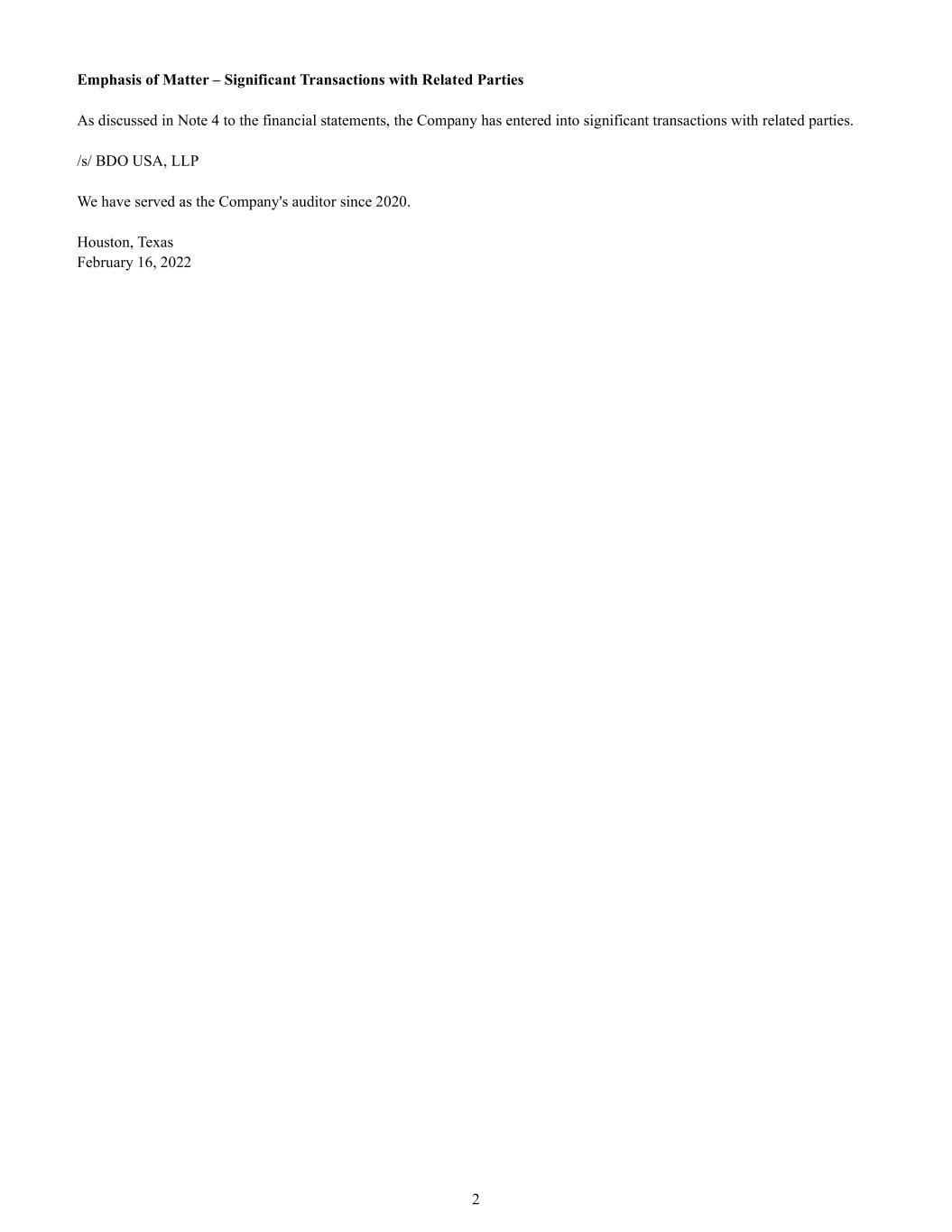
2 Emphasis of Matter – Significant Transactions with Related Parties As discussed in Note 4 to the financial statements, the Company has entered into significant transactions with related parties. /s/ BDO USA, LLP We have served as the Company's auditor since 2020. Houston, Texas February 16, 2022
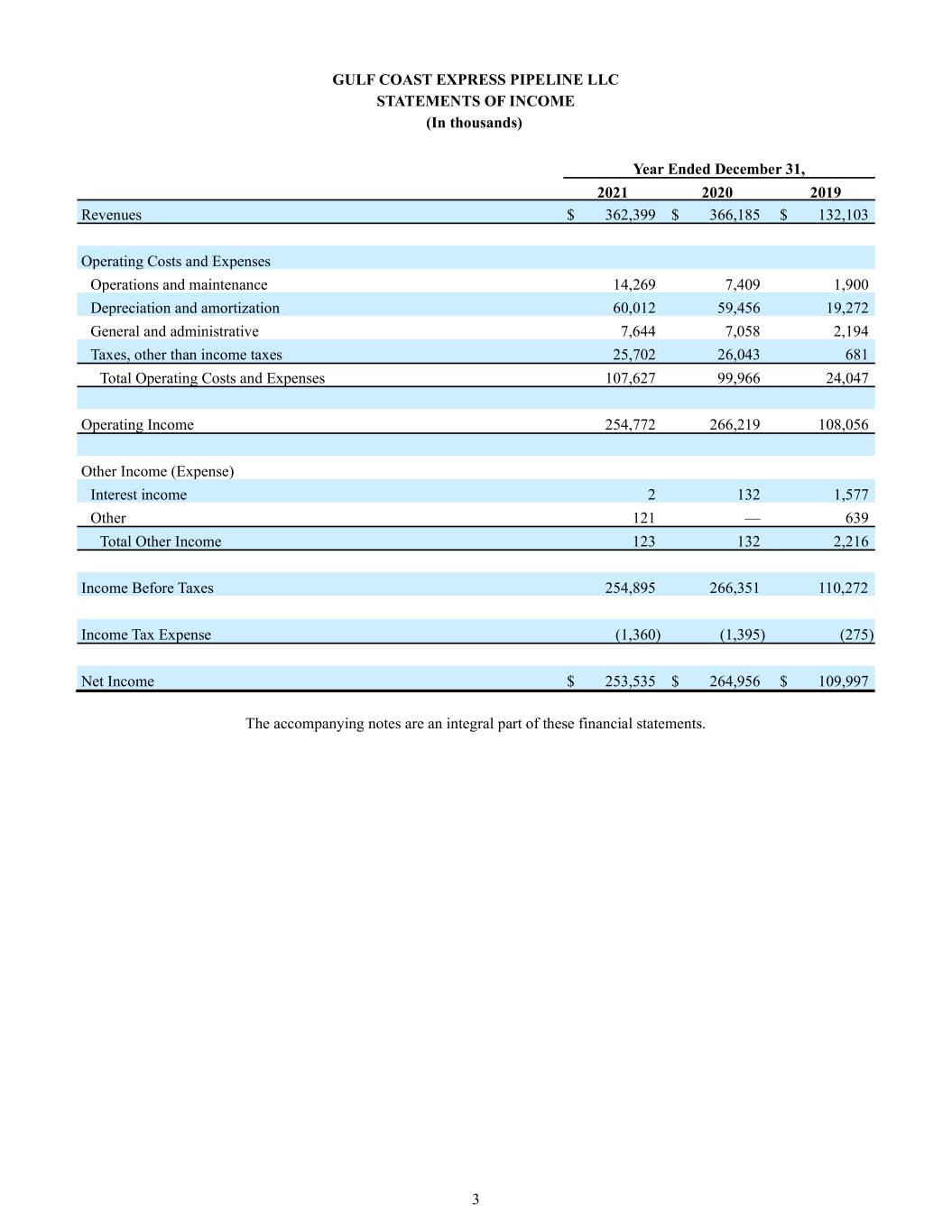
3 GULF COAST EXPRESS PIPELINE LLC STATEMENTS OF INCOME (In thousands) Year Ended December 31, 2021 2020 2019 Revenues $ 362,399 $ 366,185 $ 132,103 Operating Costs and Expenses Operations and maintenance 14,269 7,409 1,900 Depreciation and amortization 60,012 59,456 19,272 General and administrative 7,644 7,058 2,194 Taxes, other than income taxes 25,702 26,043 681 Total Operating Costs and Expenses 107,627 99,966 24,047 Operating Income 254,772 266,219 108,056 Other Income (Expense) Interest income 2 132 1,577 Other 121 — 639 Total Other Income 123 132 2,216 Income Before Taxes 254,895 266,351 110,272 Income Tax Expense (1,360) (1,395) (275) Net Income $ 253,535 $ 264,956 $ 109,997 The accompanying notes are an integral part of these financial statements.
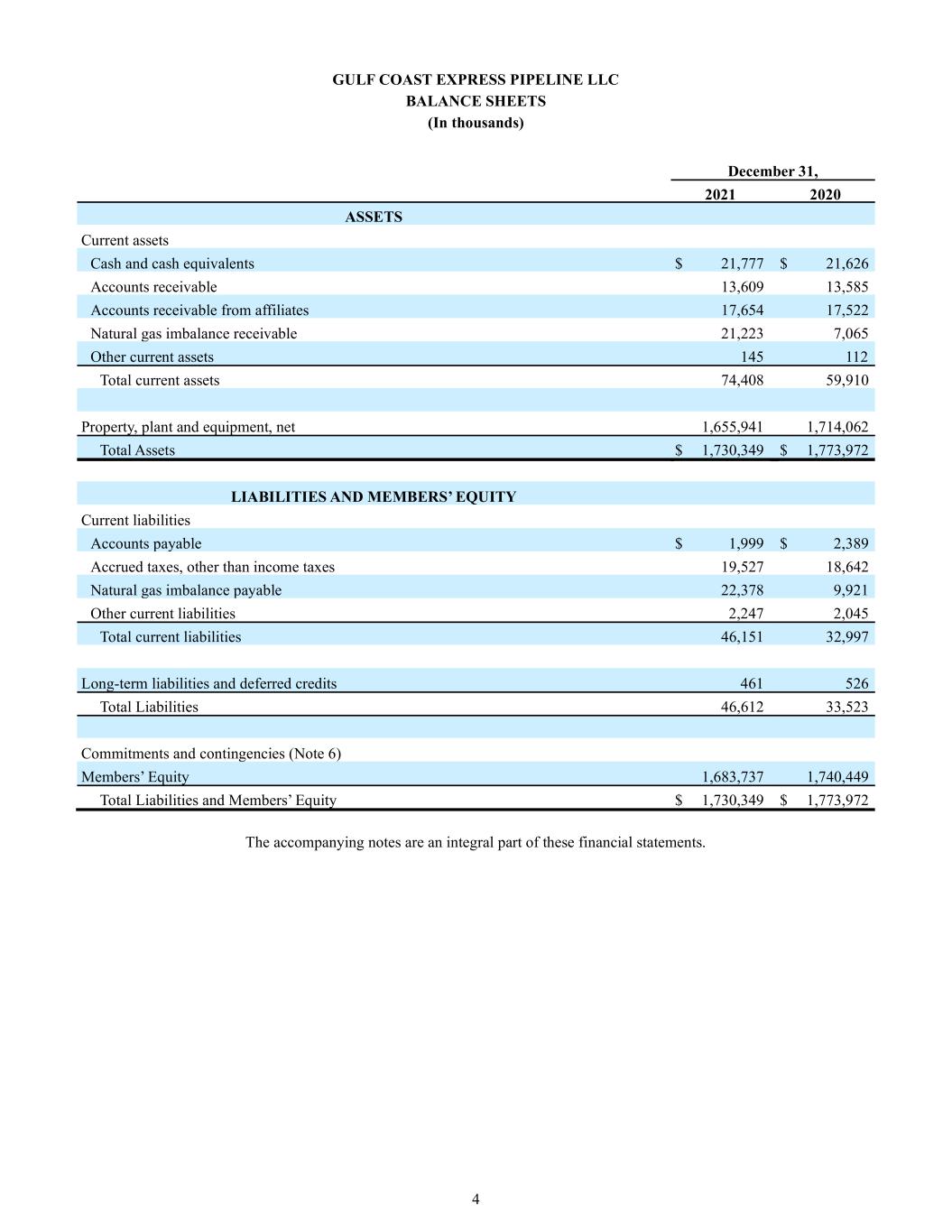
4 GULF COAST EXPRESS PIPELINE LLC BALANCE SHEETS (In thousands) December 31, 2021 2020 ASSETS Current assets Cash and cash equivalents $ 21,777 $ 21,626 Accounts receivable 13,609 13,585 Accounts receivable from affiliates 17,654 17,522 Natural gas imbalance receivable 21,223 7,065 Other current assets 145 112 Total current assets 74,408 59,910 Property, plant and equipment, net 1,655,941 1,714,062 Total Assets $ 1,730,349 $ 1,773,972 LIABILITIES AND MEMBERS’ EQUITY Current liabilities Accounts payable $ 1,999 $ 2,389 Accrued taxes, other than income taxes 19,527 18,642 Natural gas imbalance payable 22,378 9,921 Other current liabilities 2,247 2,045 Total current liabilities 46,151 32,997 Long-term liabilities and deferred credits 461 526 Total Liabilities 46,612 33,523 Commitments and contingencies (Note 6) Members’ Equity 1,683,737 1,740,449 Total Liabilities and Members’ Equity $ 1,730,349 $ 1,773,972 The accompanying notes are an integral part of these financial statements.

5 GULF COAST EXPRESS PIPELINE LLC STATEMENTS OF CASH FLOWS (In thousands) Year Ended December 31, 2021 2020 2019 Cash Flows From Operating Activities Net income $ 253,535 $ 264,956 $ 109,997 Adjustment to reconcile net income to net cash provided by operating activities: Depreciation and amortization 60,012 59,456 19,272 Changes in components of working capital: Accounts receivable (156) 7,982 (37,447) Accounts payable (89) (86) 868 Accrued taxes, other than income 885 15,184 3,457 Other current assets and liabilities (1,532) 3,367 447 Other long-term assets and liabilities (65) (56) 286 Net Cash Provided by Operating Activities 312,590 350,803 96,880 Cash Flows From Investing Activities Capital expenditures (2,192) (47,605) (1,172,136) Net Cash Used in Investing Activities (2,192) (47,605) (1,172,136) Cash Flows From Financing Activities Contributions from Members 1,961 10,722 1,135,128 Distributions to Members (312,208) (325,058) (101,302) Net Cash (Used in) Provided by Financing Activities (310,247) (314,336) 1,033,826 Net Increase (Decrease) in Cash and Cash Equivalents 151 (11,138) (41,430) Cash and Cash Equivalents, beginning of period 21,626 32,764 74,194 Cash and Cash Equivalents, end of period $ 21,777 $ 21,626 $ 32,764 The accompanying notes are an integral part of these financial statements.
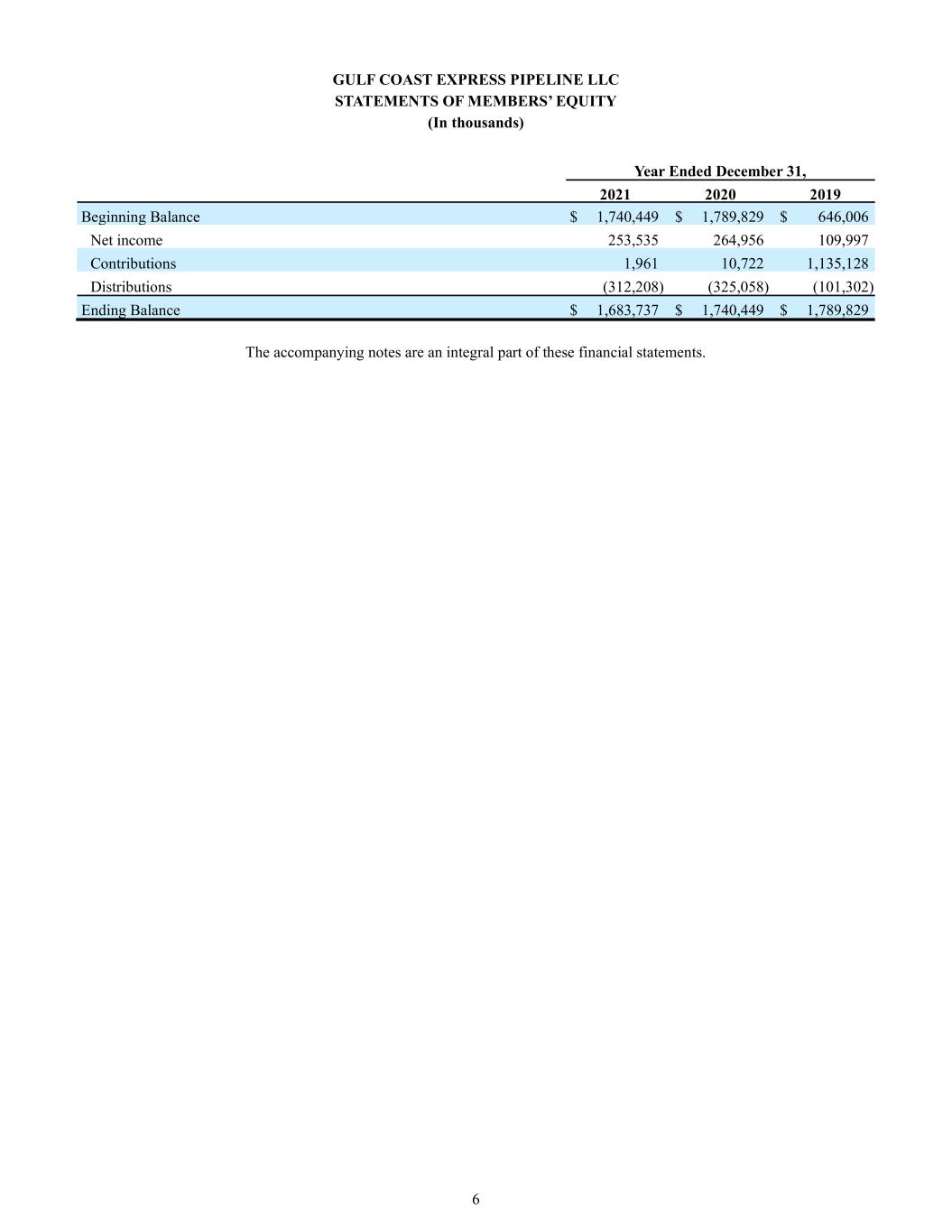
6 GULF COAST EXPRESS PIPELINE LLC STATEMENTS OF MEMBERS’ EQUITY (In thousands) Year Ended December 31, 2021 2020 2019 Beginning Balance $ 1,740,449 $ 1,789,829 $ 646,006 Net income 253,535 264,956 109,997 Contributions 1,961 10,722 1,135,128 Distributions (312,208) (325,058) (101,302) Ending Balance $ 1,683,737 $ 1,740,449 $ 1,789,829 The accompanying notes are an integral part of these financial statements.
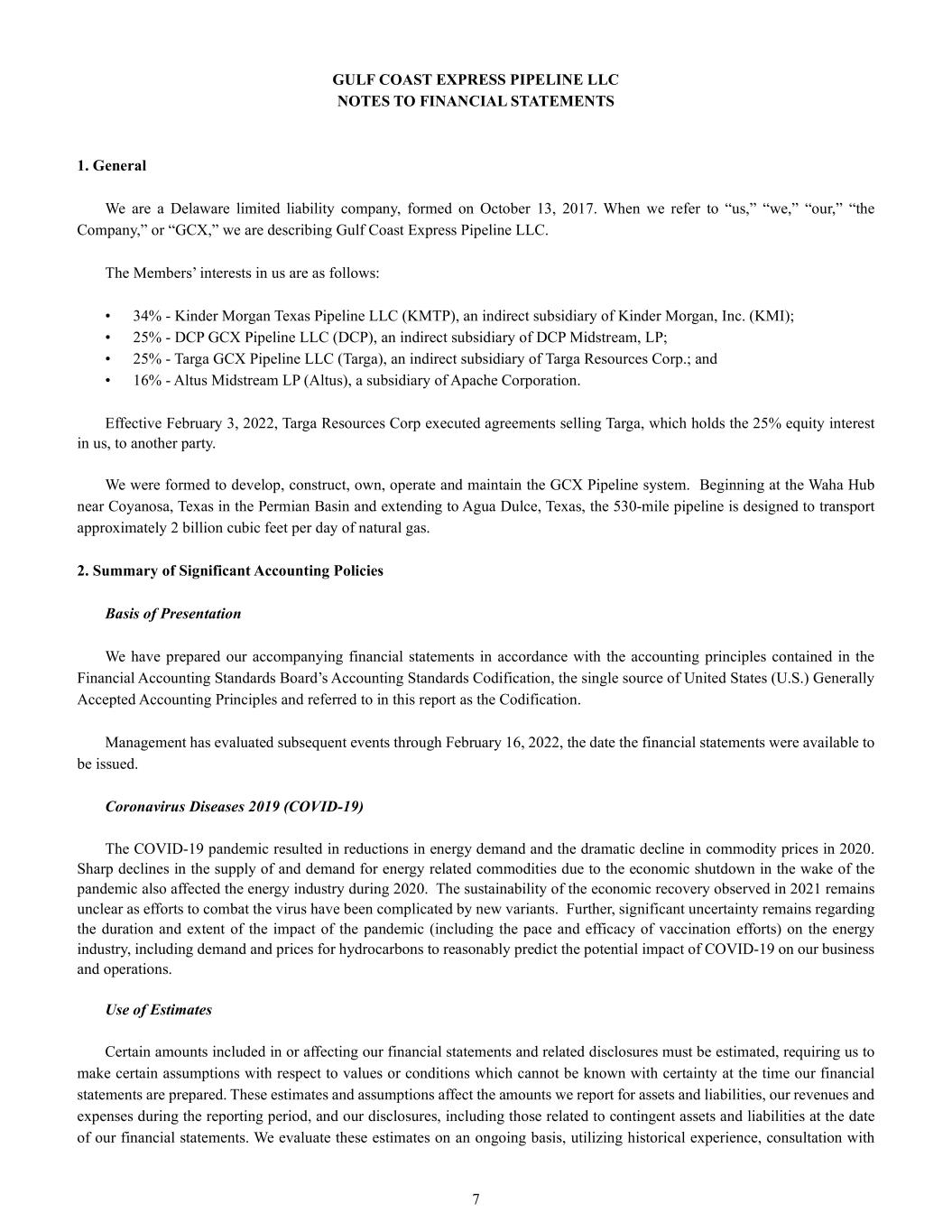
7 GULF COAST EXPRESS PIPELINE LLC NOTES TO FINANCIAL STATEMENTS 1. General We are a Delaware limited liability company, formed on October 13, 2017. When we refer to “us,” “we,” “our,” “the Company,” or “GCX,” we are describing Gulf Coast Express Pipeline LLC. The Members’ interests in us are as follows: • 34% - Kinder Morgan Texas Pipeline LLC (KMTP), an indirect subsidiary of Kinder Morgan, Inc. (KMI); • 25% - DCP GCX Pipeline LLC (DCP), an indirect subsidiary of DCP Midstream, LP; • 25% - Targa GCX Pipeline LLC (Targa), an indirect subsidiary of Targa Resources Corp.; and • 16% - Altus Midstream LP (Altus), a subsidiary of Apache Corporation. Effective February 3, 2022, Targa Resources Corp executed agreements selling Targa, which holds the 25% equity interest in us, to another party. We were formed to develop, construct, own, operate and maintain the GCX Pipeline system. Beginning at the Waha Hub near Coyanosa, Texas in the Permian Basin and extending to Agua Dulce, Texas, the 530-mile pipeline is designed to transport approximately 2 billion cubic feet per day of natural gas. 2. Summary of Significant Accounting Policies Basis of Presentation We have prepared our accompanying financial statements in accordance with the accounting principles contained in the Financial Accounting Standards Board’s Accounting Standards Codification, the single source of United States (U.S.) Generally Accepted Accounting Principles and referred to in this report as the Codification. Management has evaluated subsequent events through February 16, 2022, the date the financial statements were available to be issued. Coronavirus Diseases 2019 (COVID-19) The COVID-19 pandemic resulted in reductions in energy demand and the dramatic decline in commodity prices in 2020. Sharp declines in the supply of and demand for energy related commodities due to the economic shutdown in the wake of the pandemic also affected the energy industry during 2020. The sustainability of the economic recovery observed in 2021 remains unclear as efforts to combat the virus have been complicated by new variants. Further, significant uncertainty remains regarding the duration and extent of the impact of the pandemic (including the pace and efficacy of vaccination efforts) on the energy industry, including demand and prices for hydrocarbons to reasonably predict the potential impact of COVID-19 on our business and operations. Use of Estimates Certain amounts included in or affecting our financial statements and related disclosures must be estimated, requiring us to make certain assumptions with respect to values or conditions which cannot be known with certainty at the time our financial statements are prepared. These estimates and assumptions affect the amounts we report for assets and liabilities, our revenues and expenses during the reporting period, and our disclosures, including those related to contingent assets and liabilities at the date of our financial statements. We evaluate these estimates on an ongoing basis, utilizing historical experience, consultation with

8 experts and other methods we consider reasonable in the particular circumstances. Nevertheless, actual results may differ significantly from our estimates. Any effects on our business, financial position or results of operations resulting from revisions to these estimates are recorded in the period in which the facts that give rise to the revision become known. Certain accounting policies are of more significance in our financial statement preparation process than others, and set out below are the principal accounting policies we apply in the preparation of our financial statements. Cash Equivalents We define cash equivalents as all highly liquid short-term investments with original maturities of three months or less. Allowance for Credit Losses We evaluate our financial assets measured at amortized cost and off-balance sheet credit exposures for expected credit losses over the contractual term of the asset or exposure. We consider available information relevant to assessing the collectability of cash flows including the expected risk of credit loss even if that risk is remote. We measure expected credit losses on a collective (pool) basis when similar risk characteristics exist and we reflect the expected credit losses on the amortized cost basis of the financial asset as of the reporting date. Our financial instruments primarily consist of our accounts receivable from customers. We utilized historical analysis of credit losses experienced over the previous five years along with current conditions and reasonable and supportable forecasts of future conditions in our evaluation of collectability of our financial assets. We had no allowance for credit losses recorded as of December 31, 2021 and 2020. Natural Gas Imbalances Natural gas imbalances occur when the amount of natural gas delivered from or received by a pipeline system differs from the scheduled amount of gas to be delivered or received. We value these imbalances due to or from shippers and operators at current index prices. Imbalances are settled in cash or made up in-kind. Imbalances due from others are reported on our accompanying Balance Sheets in “Natural gas imbalance receivable.” Imbalances owed to others are reported on our accompanying Balance Sheets in “Natural gas imbalance payable.” We classify all imbalances due from or owed to others as current as we expect to settle them within a year. Property, Plant and Equipment, net Our property, plant and equipment is recorded at its original cost of construction. For constructed assets, we capitalize all construction-related direct labor and material costs. We expense costs for routine maintenance and repairs in the period incurred. We use the composite method to depreciate our property, plant and equipment. Under this method, assets with similar economic characteristics are grouped and depreciated as one asset. When property, plant and equipment is retired, accumulated depreciation and amortization is charged for the original cost of the assets in addition to the cost to remove, sell or dispose of the assets, less salvage value. We do not recognize gains or losses upon normal retirement of assets under the composite depreciation method. Asset Retirement Obligations (ARO) We record liabilities for obligations related to the retirement and removal of long-lived assets used in our businesses. We record, as liabilities, the fair value of ARO on a discounted basis when they are incurred and can be reasonably estimated, which is typically at the time the assets are installed or acquired. Amounts recorded for the related assets are increased by the amount of these obligations. Over time, the liabilities increase due to the change in their present value, and the initial capitalized costs
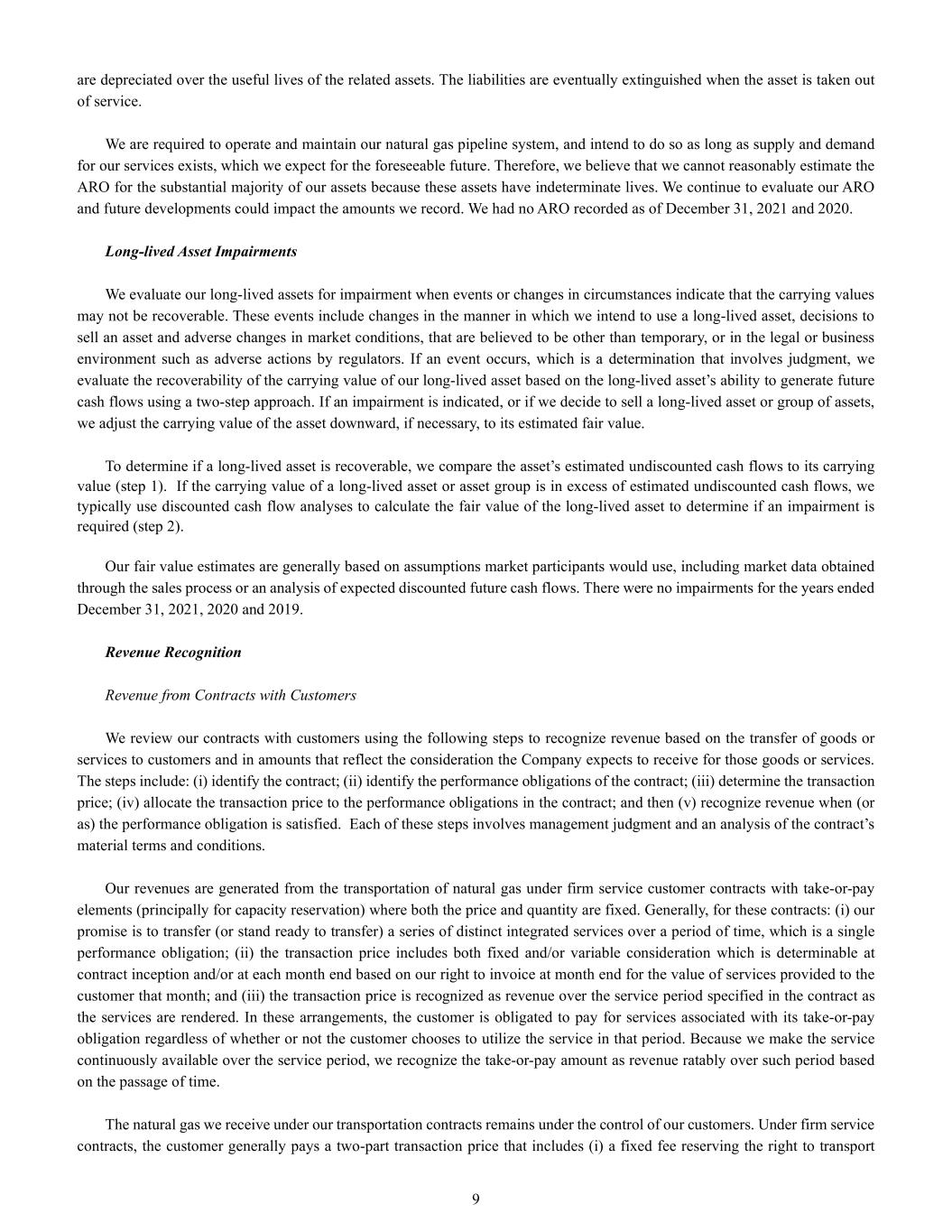
9 are depreciated over the useful lives of the related assets. The liabilities are eventually extinguished when the asset is taken out of service. We are required to operate and maintain our natural gas pipeline system, and intend to do so as long as supply and demand for our services exists, which we expect for the foreseeable future. Therefore, we believe that we cannot reasonably estimate the ARO for the substantial majority of our assets because these assets have indeterminate lives. We continue to evaluate our ARO and future developments could impact the amounts we record. We had no ARO recorded as of December 31, 2021 and 2020. Long-lived Asset Impairments We evaluate our long-lived assets for impairment when events or changes in circumstances indicate that the carrying values may not be recoverable. These events include changes in the manner in which we intend to use a long-lived asset, decisions to sell an asset and adverse changes in market conditions, that are believed to be other than temporary, or in the legal or business environment such as adverse actions by regulators. If an event occurs, which is a determination that involves judgment, we evaluate the recoverability of the carrying value of our long-lived asset based on the long-lived asset’s ability to generate future cash flows using a two-step approach. If an impairment is indicated, or if we decide to sell a long-lived asset or group of assets, we adjust the carrying value of the asset downward, if necessary, to its estimated fair value. To determine if a long-lived asset is recoverable, we compare the asset’s estimated undiscounted cash flows to its carrying value (step 1). If the carrying value of a long-lived asset or asset group is in excess of estimated undiscounted cash flows, we typically use discounted cash flow analyses to calculate the fair value of the long-lived asset to determine if an impairment is required (step 2). Our fair value estimates are generally based on assumptions market participants would use, including market data obtained through the sales process or an analysis of expected discounted future cash flows. There were no impairments for the years ended December 31, 2021, 2020 and 2019. Revenue Recognition Revenue from Contracts with Customers We review our contracts with customers using the following steps to recognize revenue based on the transfer of goods or services to customers and in amounts that reflect the consideration the Company expects to receive for those goods or services. The steps include: (i) identify the contract; (ii) identify the performance obligations of the contract; (iii) determine the transaction price; (iv) allocate the transaction price to the performance obligations in the contract; and then (v) recognize revenue when (or as) the performance obligation is satisfied. Each of these steps involves management judgment and an analysis of the contract’s material terms and conditions. Our revenues are generated from the transportation of natural gas under firm service customer contracts with take-or-pay elements (principally for capacity reservation) where both the price and quantity are fixed. Generally, for these contracts: (i) our promise is to transfer (or stand ready to transfer) a series of distinct integrated services over a period of time, which is a single performance obligation; (ii) the transaction price includes both fixed and/or variable consideration which is determinable at contract inception and/or at each month end based on our right to invoice at month end for the value of services provided to the customer that month; and (iii) the transaction price is recognized as revenue over the service period specified in the contract as the services are rendered. In these arrangements, the customer is obligated to pay for services associated with its take-or-pay obligation regardless of whether or not the customer chooses to utilize the service in that period. Because we make the service continuously available over the service period, we recognize the take-or-pay amount as revenue ratably over such period based on the passage of time. The natural gas we receive under our transportation contracts remains under the control of our customers. Under firm service contracts, the customer generally pays a two-part transaction price that includes (i) a fixed fee reserving the right to transport
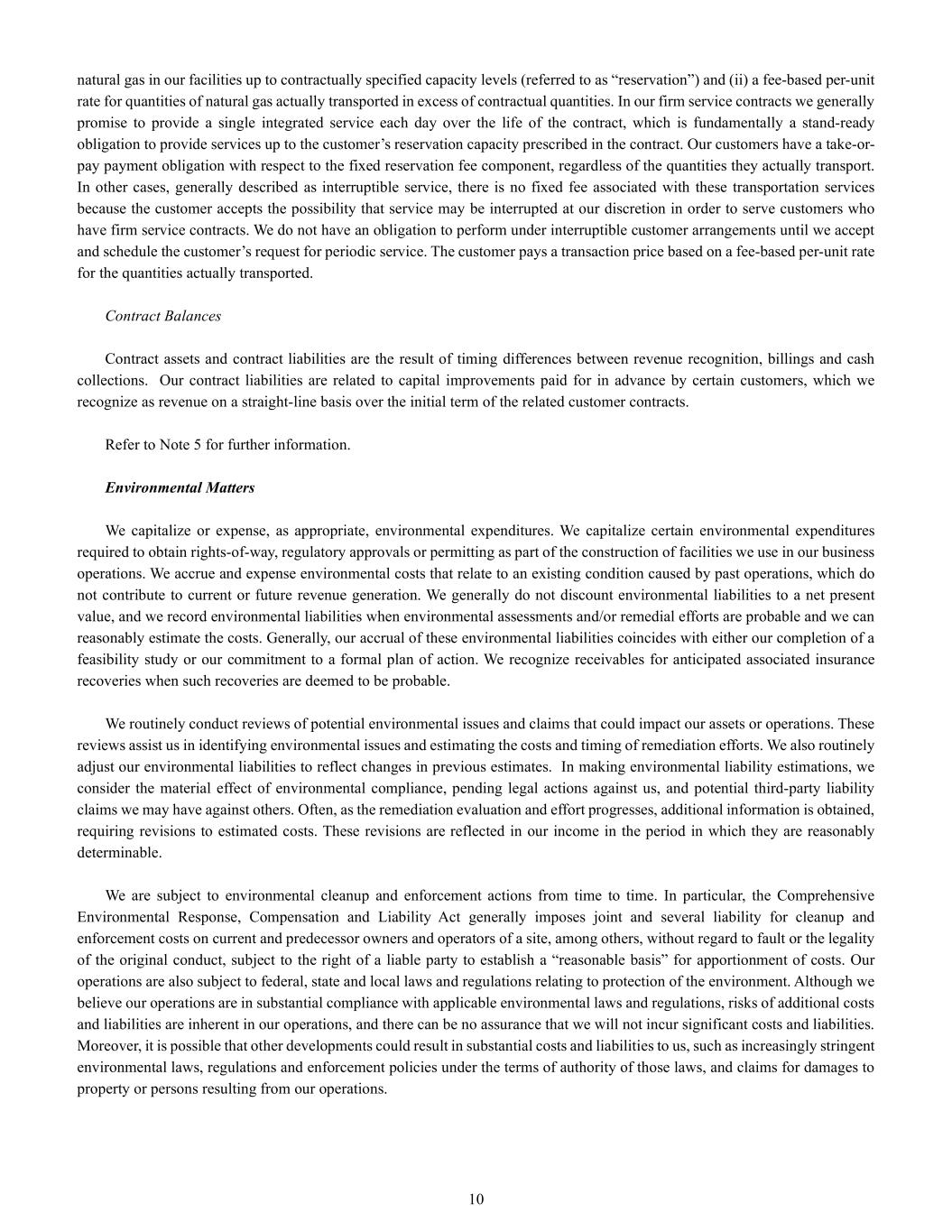
10 natural gas in our facilities up to contractually specified capacity levels (referred to as “reservation”) and (ii) a fee-based per-unit rate for quantities of natural gas actually transported in excess of contractual quantities. In our firm service contracts we generally promise to provide a single integrated service each day over the life of the contract, which is fundamentally a stand-ready obligation to provide services up to the customer’s reservation capacity prescribed in the contract. Our customers have a take-or- pay payment obligation with respect to the fixed reservation fee component, regardless of the quantities they actually transport. In other cases, generally described as interruptible service, there is no fixed fee associated with these transportation services because the customer accepts the possibility that service may be interrupted at our discretion in order to serve customers who have firm service contracts. We do not have an obligation to perform under interruptible customer arrangements until we accept and schedule the customer’s request for periodic service. The customer pays a transaction price based on a fee-based per-unit rate for the quantities actually transported. Contract Balances Contract assets and contract liabilities are the result of timing differences between revenue recognition, billings and cash collections. Our contract liabilities are related to capital improvements paid for in advance by certain customers, which we recognize as revenue on a straight-line basis over the initial term of the related customer contracts. Refer to Note 5 for further information. Environmental Matters We capitalize or expense, as appropriate, environmental expenditures. We capitalize certain environmental expenditures required to obtain rights-of-way, regulatory approvals or permitting as part of the construction of facilities we use in our business operations. We accrue and expense environmental costs that relate to an existing condition caused by past operations, which do not contribute to current or future revenue generation. We generally do not discount environmental liabilities to a net present value, and we record environmental liabilities when environmental assessments and/or remedial efforts are probable and we can reasonably estimate the costs. Generally, our accrual of these environmental liabilities coincides with either our completion of a feasibility study or our commitment to a formal plan of action. We recognize receivables for anticipated associated insurance recoveries when such recoveries are deemed to be probable. We routinely conduct reviews of potential environmental issues and claims that could impact our assets or operations. These reviews assist us in identifying environmental issues and estimating the costs and timing of remediation efforts. We also routinely adjust our environmental liabilities to reflect changes in previous estimates. In making environmental liability estimations, we consider the material effect of environmental compliance, pending legal actions against us, and potential third-party liability claims we may have against others. Often, as the remediation evaluation and effort progresses, additional information is obtained, requiring revisions to estimated costs. These revisions are reflected in our income in the period in which they are reasonably determinable. We are subject to environmental cleanup and enforcement actions from time to time. In particular, the Comprehensive Environmental Response, Compensation and Liability Act generally imposes joint and several liability for cleanup and enforcement costs on current and predecessor owners and operators of a site, among others, without regard to fault or the legality of the original conduct, subject to the right of a liable party to establish a “reasonable basis” for apportionment of costs. Our operations are also subject to federal, state and local laws and regulations relating to protection of the environment. Although we believe our operations are in substantial compliance with applicable environmental laws and regulations, risks of additional costs and liabilities are inherent in our operations, and there can be no assurance that we will not incur significant costs and liabilities. Moreover, it is possible that other developments could result in substantial costs and liabilities to us, such as increasingly stringent environmental laws, regulations and enforcement policies under the terms of authority of those laws, and claims for damages to property or persons resulting from our operations.
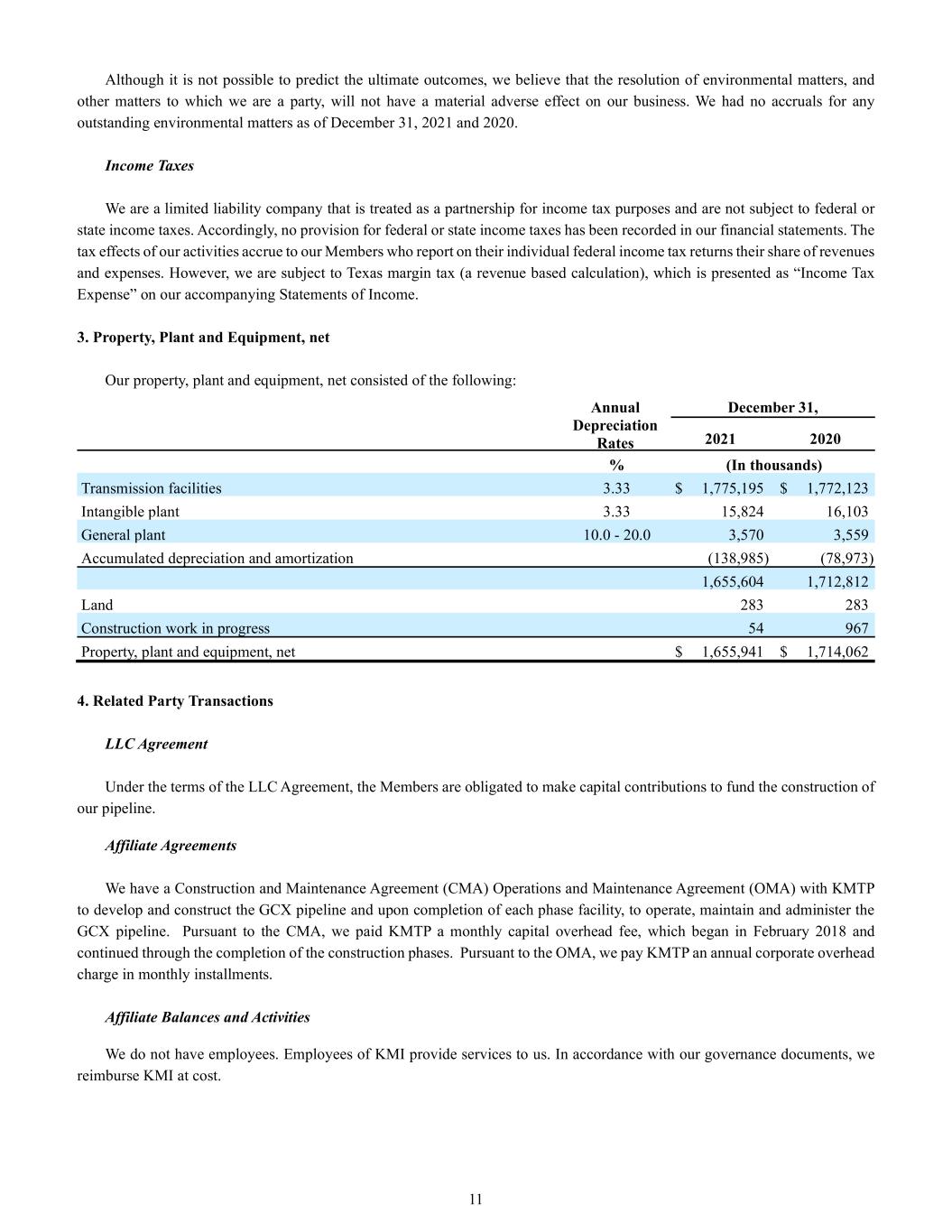
11 Although it is not possible to predict the ultimate outcomes, we believe that the resolution of environmental matters, and other matters to which we are a party, will not have a material adverse effect on our business. We had no accruals for any outstanding environmental matters as of December 31, 2021 and 2020. Income Taxes We are a limited liability company that is treated as a partnership for income tax purposes and are not subject to federal or state income taxes. Accordingly, no provision for federal or state income taxes has been recorded in our financial statements. The tax effects of our activities accrue to our Members who report on their individual federal income tax returns their share of revenues and expenses. However, we are subject to Texas margin tax (a revenue based calculation), which is presented as “Income Tax Expense” on our accompanying Statements of Income. 3. Property, Plant and Equipment, net Our property, plant and equipment, net consisted of the following: Annual Depreciation Rates December 31, 2021 2020 % (In thousands) Transmission facilities 3.33 $ 1,775,195 $ 1,772,123 Intangible plant 3.33 15,824 16,103 General plant 10.0 - 20.0 3,570 3,559 Accumulated depreciation and amortization (138,985) (78,973) 1,655,604 1,712,812 Land 283 283 Construction work in progress 54 967 Property, plant and equipment, net $ 1,655,941 $ 1,714,062 4. Related Party Transactions LLC Agreement Under the terms of the LLC Agreement, the Members are obligated to make capital contributions to fund the construction of our pipeline. Affiliate Agreements We have a Construction and Maintenance Agreement (CMA) Operations and Maintenance Agreement (OMA) with KMTP to develop and construct the GCX pipeline and upon completion of each phase facility, to operate, maintain and administer the GCX pipeline. Pursuant to the CMA, we paid KMTP a monthly capital overhead fee, which began in February 2018 and continued through the completion of the construction phases. Pursuant to the OMA, we pay KMTP an annual corporate overhead charge in monthly installments. Affiliate Balances and Activities We do not have employees. Employees of KMI provide services to us. In accordance with our governance documents, we reimburse KMI at cost.
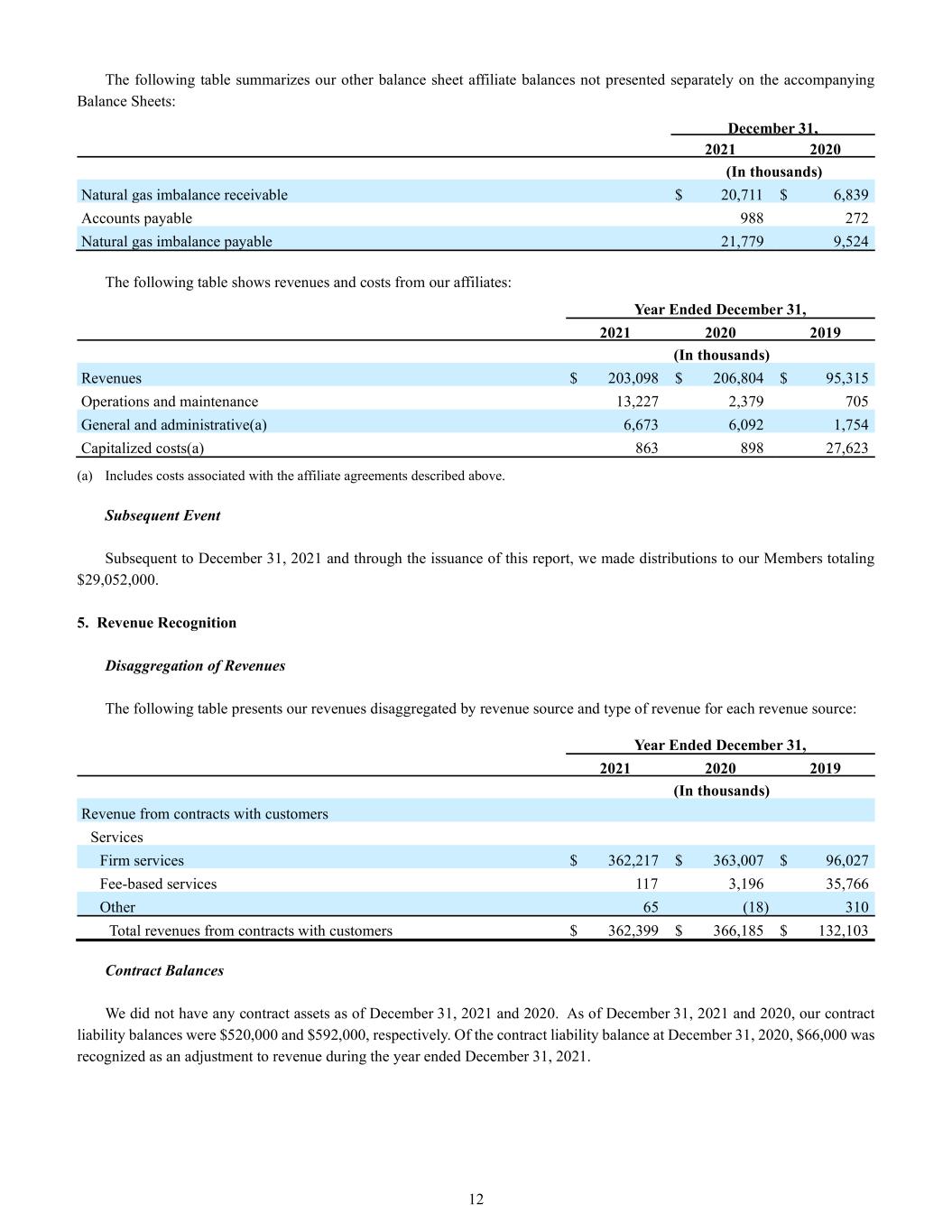
12 The following table summarizes our other balance sheet affiliate balances not presented separately on the accompanying Balance Sheets: December 31, 2021 2020 (In thousands) Natural gas imbalance receivable $ 20,711 $ 6,839 Accounts payable 988 272 Natural gas imbalance payable 21,779 9,524 The following table shows revenues and costs from our affiliates: Year Ended December 31, 2021 2020 2019 (In thousands) Revenues $ 203,098 $ 206,804 $ 95,315 Operations and maintenance 13,227 2,379 705 General and administrative(a) 6,673 6,092 1,754 Capitalized costs(a) 863 898 27,623 (a) Includes costs associated with the affiliate agreements described above. Subsequent Event Subsequent to December 31, 2021 and through the issuance of this report, we made distributions to our Members totaling $29,052,000. 5. Revenue Recognition Disaggregation of Revenues The following table presents our revenues disaggregated by revenue source and type of revenue for each revenue source: Year Ended December 31, 2021 2020 2019 (In thousands) Revenue from contracts with customers Services Firm services $ 362,217 $ 363,007 $ 96,027 Fee-based services 117 3,196 35,766 Other 65 (18) 310 Total revenues from contracts with customers $ 362,399 $ 366,185 $ 132,103 Contract Balances We did not have any contract assets as of December 31, 2021 and 2020. As of December 31, 2021 and 2020, our contract liability balances were $520,000 and $592,000, respectively. Of the contract liability balance at December 31, 2020, $66,000 was recognized as an adjustment to revenue during the year ended December 31, 2021.

13 Revenue Allocated to Remaining Performance Obligations The following table presents our estimated revenue allocated to remaining performance obligations for contracted revenue that has not yet been recognized, representing our “contractually committed” revenue as of December 31, 2021 that we will invoice or transfer from contract liabilities and recognize in future periods: Year Estimated Revenue (In thousands) 2022 $ 363,105 2023 363,105 2024 364,100 2025 363,105 2026 363,105 Thereafter 996,085 Total $ 2,812,605 Our contractually committed revenue, for purposes of the tabular presentation above, is generally limited to service customer contracts which have fixed pricing and fixed volume terms and conditions, generally including contracts with take-or-pay payment obligations. Our contractually committed revenue amounts generally exclude, based on the following practical expedient that we elected to apply, remaining performance obligations for contracts with variable volume attributes in which such variable consideration is allocated entirely to a wholly unsatisfied performance obligation. Major Customers The following table presents revenues from our largest customers, each of which exceeded 10% of our revenues as determined for each year individually and irrespective of the other periods presented below: Year Ended December 31, 2021 2020 2019 (In thousands) Revenues from largest affiliated customer (number one) $ 65,559 $ 66,796 $ 29,546 Revenues from largest affiliated customer (number two) 55,581 53,143 28,805 Revenues from largest affiliated customer (number three) 41,518 43,972 17,836 Revenues from largest affiliated customer (number four) 40,440 42,623 n/a Revenues from largest non-affiliated customer 56,208 56,222 18,049 n/a - not applicable 6. Litigation and Commitments We are party to various legal, regulatory and other matters arising from the day-to-day operations of our business that may result in claims against the Company. Although no assurance can be given, we believe, based on our experiences to date and taking into account established reserves, that the ultimate resolution of such items will not have a material adverse impact on our business. We believe we have meritorious defenses to the matters to which we are a party and intend to vigorously defend the Company. When we determine a loss is probable of occurring and is reasonably estimable, we accrue an undiscounted liability for such contingencies based on our best estimate using information available at that time. If the estimated loss is a range of potential outcomes and there is no better estimate within the range, we accrue the amount at the low end of the range. We disclose contingencies where an adverse outcome may be material, or in the judgment of management, we conclude the matter should otherwise be disclosed.

14 Legal Proceeding Dispute with Pipe Supplier In January 2018, GCX entered into an agreement with Borusan Mannesmann Bore Sanayi ve Tricare A.S. (Borusan), a steel pipe producer in Turkey, under which Borusan supplied highly specialized steel pipe for the GCX project. Total pipe costs are approximately $172.5 million. During March 2018, the U.S. government, pursuant to Section 232 of the Trade Expansion Act of 1962 (Section 232), announced a 25% tariff on steel imported from Turkey, including steel pipe. The tariff was later increased to 50%. The amount of the Section 232 tariff applicable to the pipe supplied by Borusan to GCX is $74.3 million. GCX and Borusan each allege the other party is responsible to pay the tariff. During May 2018, GCX made a request to the U.S. Department of Commerce (DOC) for an exclusion from the Section 232 tariffs. On April 23, 2019, GCX was informed that its request for an exclusion was denied. On June 11, 2019, GCX resubmitted its request for an exclusion from the Section 232 tariff. GCX took possession of the Borusan supplied pipe in February 2019. Thereafter, GCX both exercised its legal right to set off the amount of the disputed tariff from unpaid invoices sent to GCX by Borusan and demanded that Borusan reimburse GCX for the amount of the tariff previously paid by GCX to Borusan. GCX is currently setting off $37.2 million from the amount Borusan claims it is owed and demanding that Borusan return $37.1 million to GCX. On January 28, 2020, GCX filed a lawsuit against Borusan in the U.S. District Court for the Southern District of Texas alleging breach of contract and seeking a judicial declaration of GCX’s rights under the parties’ agreement. The case is captioned Gulf Coast Express Pipeline, LLC v. Borusan Mannesmann Bore Sanayi ve Tricare A.S. On May 22, 2020, the DOC approved GCX’s request for an exclusion from the Section 232 tariff. GCX and Borusan sought to secure refunds of the Section 232 tariffs paid from the U.S. Bureau of Customs and Border Protection (CBP), who has not yet provided the refunds to GCX and Borusan. GCX and Borusan have agreed to an administrative stay of the litigation in the U.S. District Court for the Southern District of Texas and advanced litigation against CBP to secure the Section 232 tariff refunds in the U.S. Court of International Trade. That case is captioned Borusan Mannesmann Bore Sanayi ve Tricare A.S. et al v. United States. General We had no accruals for any outstanding legal proceedings as of December 31, 2021 and 2020. Commitments As of December 31, 2021, we had capital commitments of approximately $663,000 for purchases related to construction work in progress.















